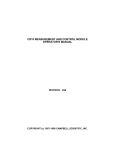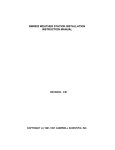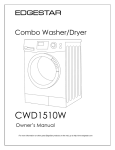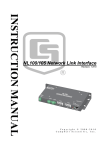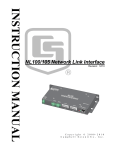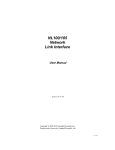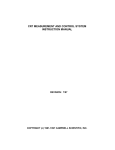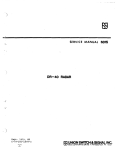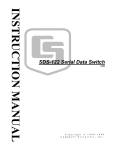Download Campbell DSP4 Operator`s manual
Transcript
CR10X MEASUREMENT AND CONTROL MODULE OPERATOR'S MANUAL REVISION: 9/01 COPYRIGHT (c) 1986-2001 CAMPBELL SCIENTIFIC, INC. This is a blank page. CR10X MEASUREMENT AND CONTROL MODULE OVERVIEW The CR10X is a fully programmable datalogger/controller with non-volatile memory and a battery backed clock in a small, rugged, sealed module. The combination of reliability, versatility, and telecommunications support make it a favorite choice for networks and single logger applications. Campbell Scientific Inc. provides four aids to operating the CR10X: 1. 2. 3. 4. PCTOUR This Overview The CR10X Operator's Manual The CR10X Prompt Sheet PCTOUR is a computer-guided tour of CR10X operation and the use of the PC208 Datalogger Support Software. Much of the material in this Overview is covered in PCTOUR. A copy of PCTOUR is available on our web site www.campbellsci.com. This Overview introduces the concepts required to take advantage of the CR10X's capabilities. Handson programming examples start in Section OV5. Working with a CR10X will help the learning process, so don't just read the examples, do them. If you want to start this minute, go ahead and try the examples, then come back and read the rest of the Overview. The sections of the Operator's Manual which should be read to complete a basic understanding of the CR10X operation are the Programming Sections 1-3, the portions of the data retrieval Sections 4 and 5 appropriate to the method(s) you are using (see OV6), and Section 14 which covers installation and maintenance. Section 6 covers details of serial communications. Sections 7 and 8 contain programming examples. Sections 9-12 have detailed descriptions of each programming instruction, and Section 13 goes into detail on the CR10X measurement procedures. The Prompt Sheet is an abbreviated description of the programming instructions. Once familiar with the CR10X, it is possible to program it using only the Prompt Sheet as a reference, consulting the manual if further detail is needed. Read the Selected Operating Details and Cautionary Notes at the front of the Manual before using the CR10X. OV1. PHYSICAL DESCRIPTION The CR10X was designed to provide a rugged sealed datalogger with a low per unit cost. Some of its distinguishing physical features are: • The CR10X does not have an integral keyboard/display. The user accesses the CR10X with the portable CR10KD Keyboard Display or with a computer or terminal (Section OV2). • The CR10X does not have an integral terminal strip. A removable wiring panel (Figure OV1.1-1) performs this function and attaches to the two D-type connectors located at the end of the module. • The power supply is external to the CR10X. This gives the user a wide range of options (Section 14) for powering the CR10X. OV1.1 WIRING PANEL The CR10X Wiring Panel and CR10X datalogger make electrical contact through the two D-type connectors at the (left) end of the CR10X. The Wiring Panel contains a 9-pin Serial I/O port used when communicating with the datalogger and provides terminals for connecting sensor, control, and power leads to the CR10X. It also provides transient protection and reverse polarity protection. Figure OV1.1-2 shows the panel and the instructions used to access the various terminals. OV-1 CR10X OVERVIEW CR10XTCR Thermocouple Reference Thermistor and Cover , N A G O L H A T U E S EF D G 8 H 7 4 G L 0 1 H 9 5 G A E S EF D L 2 1 H G L 2 H 1 1 1 6 1 G G A H T D R N A U E O R C G A L 3 E G A G A 4 H 3 2 G L G 6 H 5 3 G A L G G A G G L R T C V V 2 1 12 W W S S G 3 E G A G A G G H V 2 1 ER G W O P IN L R H C G A 1 0 L X G A C S W H I/ 0 M A P G I N USA I R E IN D N V 2 1 A V 2 M 1 D 3 S E G A L E L G . IN NO IR L W E N A P M EA SU RE firmM E w NT are A N C DC 19 O 83 NT , 1 RO 98 L 6, M 19 OD 95 U LE SERIAL i/O CR 10 S/N X :X 10 12 CR10KD KEYBOARD DISPLAY 1 2 3 A 4 5 6 B 7 8 9 C * 0 # D MADE IN USA FIGURE OV1.1-1. CR10X and Wiring Panel, CR10KD, and CR10XTCR OV-2 ANALOG INPUTS CR10X OVERVIEW Input/Output Instructions 1 Volt (SE) 2 Volt (DIFF) 4 Ex-Del-Se 5 AC Half Br 6 Full Br 7 3W Half Br 8 Ex-Del-Diff 9 6W Full Br 11 Temp (107) 12 RH-(207) 13 Temp-TC SE 14 Temp-TC DIFF 16 Temp-RTD 27 Interval-Freq. 28 Vibrating Wire Meas 29 INW Press 131 Enhanced Vib. Wire SERIAL I/O Telecommunications Program Control Instructions 96 Storage Module, Printer 97 Initiate Telecommunications 120 TGT1 GOES Satellite 121 ARGOS Satellite 122 INMARSAT-C Satellite 123 TGT1 Programming Switched 12 Volts 12 Volt Power Inputs G 12V Logan, Utah SW 12V CTRL SE DIFF 7 8 9 4 G G H 10 5 L AG H L 11 12 6 AG H L AG E3 SW 12V AG G G 5V 5V G G 12V POWER IN CS I/O G CR10X WIRING PANEL MADE IN USA 1 SE DIFF 2 3 L AG H G H 4 5 L AG H 2 1 G 6 SDM 3 L AG E1 AG E2 G P1 G P2 G C8 C7 C6 C5 C4 C3 C2 C1 G 12V 12V EARTH GROUND WIRING PANEL NO. DIGITAL I/O PORTS Earth Ground Connect 12ga or larger wire to earth ground EXCITATION OUTPUTS Input/Output Instructions 4 5 6 7 8 9 11 12 22 28 29 Ex-Del-Se AC Half Br Full Br 3W Half Br Ex-Del-Diff Full Br-Mex Temp (107) RH (207) Excit-Del Wire Meas INW Press PULSE INPUTS Input/Output Instructions 3 Pulse Input/Output Instructions 3 Pulse 15 Serial I/O 20 Set Ports 21 Pulse Port 25 Read Ports 100-110, 118 SDM and SDI12 Instructions Program Control Instructions 83 If Case < F 86 Do 88 If X <=> Y 89 If X <=> F 91 If flag, port 92 If Time Command Codes: 4X Set port x high 5X Set port x low 6X Toggle port x 7X Pulse port x 96 Port Subr. 97 Port Subr. 98 Port Subr. FIGURE OV1.1-2. CR10X Wiring Panel/Programming Instructions OV-3 CR10X OVERVIEW OV1.1.1 ANALOG INPUTS OV1.1.5 ANALOG GROUND (AG) The terminals labeled 1H to 6L are analog inputs. These numbers refer to the high and low inputs to the differential channels 1 through 6. In a differential measurement, the voltage on the H input is measured with respect to the voltage on the L input. When making singleended measurements, either the H or L input may be used as an independent channel to measure voltage with respect to the CR10X analog ground (AG). The single-ended channels are numbered sequentially starting with 1H; e.g., the H and L sides of differential channel 1 are single-ended channels 1 and 2; the H and L sides of differential channel 2 are single-ended channels 3 and 4, etc. (The blue single-ended channel numbers do NOT appear on older wiring panels). The AG terminals are analog grounds, used as the reference for single-ended measurements and excitation return. OV1.1.2 EXCITATION OUTPUTS The G terminals are also used to tie cable shields to ground, and to provide a ground reference for pulse counters and binary inputs. The G terminals are directly connected to the Earth terminal. For protection against transient voltage spikes, Earth should be connected to a good earth ground (Section 14.7.1). The terminals labeled E1, E2, and E3 are precision, switched excitation outputs used to supply programmable excitation voltages for resistive bridge measurements. DC or AC excitation at voltages between -2500 mV and +2500 mV are user programmable (Section 9). OV1.1.6 12V, POWER GROUND (G), AND EARTH TERMINALS The 12V and power ground (G) terminals are used to supply 12V DC power to the datalogger. The extra 12V and G terminals can be used to connect other devices requiring unregulated 12V power. CAUTION: The CR10X does not regulate the voltage to the 12 V terminals. The 12 V terminals are connected directly to the 12 V power in terminal. Any voltage regulation must be done by the power supply (Section 14). OV1.1.7 5V OUTPUTS OV1.1.3 PULSE INPUTS The terminals labeled P1 and P2 are the pulse counter inputs for the CR10X. They are programmable for high frequency pulse, low level AC, or switch closure (Section 9, Instruction 3). OV1.1.4 DIGITAL I/O PORTS Terminals C1 through C8 are digital Input/Output ports. On power-up they are configured as input ports, commonly used for reading the status of an external signal. High and low conditions are: 3V < high < 5.5V; -0.5V < low < 0.8V. Configured as outputs the ports allow on/off control of external devices. A port can be set high (5V ± 0.1V), set low (<0.1V), toggled or pulsed (Sections 3, 8.3, and 12). Ports C6 through C8 can be configured as pulse counters for switch closures (Section 9, Instruction 3) or used to trigger subroutine execution (Section 1.1.2). The two 5V (±0.2%) outputs are commonly used to power peripherals such as the QD1 Incremental Encoder Interface, AVW1 or AVW4 Vibrating Wire Interface. The 5V outputs are common with pin 1 on the 9 pin serial connector; 200 mA is the maximum combined output. OV1.1.8 SERIAL I/O The 9 pin serial I/O port contains lines for serial communication between the CR10X and external devices such as computers, printers, Storage Modules, etc. This port does NOT have the same configuration as the 9 pin serial ports currently used on many personal computers. It has a 5VDC power line which is used to power peripherals such as the Storage Modules or the DC112 Phone Modem. The same 5VDC supply is used for the 5V outputs on the lower terminal strip. Section 6 contains technical details on serial communication. OV1.1.9 SWITCHED 12 VOLT The switched 12 volt output can be used to power sensors or devices requiring an OV-4 CR10X OVERVIEW unregulated 12 volts. The output is limited to 600 mA current. A control port is used to operate the switch. Connect a wire from the control port to the switched 12 volt control port. When the port is set high, the 12 volts is turned on; when the port is low, the switched 12 volts is off (Section 8.12). OV1.2 CONNECTING POWER TO THE CR10X The CR10X can be powered by any 12VDC source. The green power connector is a plug in connector that allows the power supply to be easily disconnected without unscrewing the terminals. The Wiring Panel power connection is reverse polarity protected. See Section 14 for details on power supply connections. CAUTION: The metal surfaces of the CR10X Wiring Panel, and CR10KD Keyboard Display are at the same potential as power ground. To avoid shorting 12 volts to ground, connect the 12 volt lead first, then connect the ground lead. When primary power falls below 9.6 VDC for one millisecond, the CR10X stops executing its programs. The Low Voltage Counter (∗B window 9) is incremented by one each time the primary power falls below 9.6 VDC and E10 is displayed on the CR10KD. A double dash (--) in the 9th window of the ∗B mode indicates that the CR10X is currently in a low primary power mode. (Section 1.6) The datalogger program and stored data remain in memory, and the clock continues to keep time when power is disconnected. The clock and SRAM are powered by an internal lithium battery. OV2. MEMORY AND PROGRAMMING CONCEPTS OV2.1 INTERNAL MEMORY The standard CR10X has 128 K of Flash Electrically Erasable Programmable Read Only Memory (EEPROM) and 128 K Static Random Access Memory (SRAM). The Flash EEPROM stores the operating system and user programs. RAM is used for data and running the program. Data Storage can be expanded with an optional Flash EEPROM (Figure OV2.1-1). The use of the Input, Intermediate, and Final Storage in the measurement and data processing sequence is shown in Figure OV2.1-2. The five areas of SRAM are: 1. System Memory - used for overhead tasks such as compiling programs, transferring data, etc. The user cannot access this memory. 2. Program Memory - available for user entered programs. 3. Input Storage - Input Storage holds the results of measurements or calculations. The ∗6 Mode is used to view Input Storage locations for checking current sensor readings or calculated values. Input Storage defaults to 28 locations. Additional locations can be assigned using the ∗A Mode. 4. Intermediate Storage - Certain Processing Instructions and most of the Output Processing Instructions maintain intermediate results in Intermediate Storage. Intermediate storage is automatically accessed by the instructions and cannot be accessed by the user. The default allocation is 64 locations. The number of locations can be changed using the ∗A Mode. 5. Final Storage - Final processed values are stored here for transfer to printer, solid state Storage Module or for retrieval via telecommunication links. Values are stored in Final Storage only by the Output Processing Instructions and only when the Output Flag is set in the user’s program. Approximately 62,000 locations are allocated to Final Storage on power up. This number is reduced if Input or Intermediate Storage is increased. While the total size of these three areas remains constant, memory may be reallocated between the areas to accommodate different measurement and processing needs (∗A Mode, Section 1.5). OV-5 CR10X OVERVIEW Flash Memory (EEPROM) Total 128 Kbytes Operating System (96 Kbytes) How it works: The Operating System is loaded into Flash Memory at the factory. System Memory is used while the CR10X is running calculations, buffering data and for general operating tasks. Any time a user loads a program into the CR10X, the program is compiled in SRAM and stored in the Active Program areas. If the CR10X is powered off and then on, the Active Program is loaded from Flash and run. The Active Program is run in SRAM to maximize speed. The program accesses Input Storage and Intermediate Storage and stores data into Final Storage for later retrieval by the user. Active Program (16 Kbytes) Stored Programs (16 Kbytes) The Active Program can be copied into the Stored Programs area. While 98 program "names" are available, the number of programs stored is limited by the available memory. Stored programs can be retrieved to become the active program. While programs are stored one at a time, all stored programs must be erased at once. That is because the flash memory can only be written to once before it must be erased and can only be erased in 16 Kbytes blocks. With the Optional Flash Memory, up to 2 Mbytes of additional memory can be added to increase Final Storage by another 524,288 data values per Mbyte. The user can allocate this extra memory to any combination of Area 1 or Area 2. (Memory Areas separated by dashed lines: can be re-sized by the user.) FIGURE OV2.1-1. CR10X Memory OV-6 SRAM Total 128 Kbytes System Memory (4096 Bytes) Active Program (default 2048 Bytes) Input Storage (default 28 locations, 112 bytes) Intermediate Storage (default 64 locations, 256 bytes) Final Storage Area 1 (default 62,280 locations, 124,560 bytes) Final Storage Area 2 (default 0 locations, 0 bytes) Optional Flash EEPROM Final Storage Area 1 and/or Final Storage Area 2 (Additional 524,288 locations per Mbyte) CR10X OVERVIEW OV2.2 PROGRAM TABLES, EXECUTION INTERVAL AND OUTPUT INTERVALS The CR10X must be programmed before it will make any measurements. A program consists of a group of instructions entered into a program table. The program table is given an execution interval which determines how frequently that table is executed. When the table is executed, the instructions are executed in sequence from beginning to end. After executing the table, the CR10X waits the remainder of the execution interval and then executes the table again starting at the beginning. The interval at which the table is executed generally determines the interval at which the sensors are measured. The interval at which data are stored is separate from how often the table is executed, and may range from samples every execution interval to processed summaries output hourly, daily, or on longer or irregular intervals. Table 1. Execute every x sec. 0.0156 < x < 8191 Instructions are executed sequentially in the order they are entered in the table. One complete pass through the table is made each execution interval unless program control instructions are used to loop or branch execution. Normal Order: MEASURE PROCESS CHECK OUTPUT COND. OUTPUT PROCESSING Programs are entered in Tables 1 and 2. Subroutines, called from Tables 1 and 2, are entered in Subroutine Table 3. The size of program memory can be fixed or automatically allocated by the CR10X (Section 1.5). Table 1 and Table 2 have independent execution intervals, entered in units of seconds with an allowable range of 1/64 to 8191 seconds. Subroutine Table 3 has no execution interval; subroutines are only executed when called from Table 1 or 2. OV2.2.1 THE EXECUTION INTERVAL The execution interval specifies how often the program in the table is executed, which is usually determined by how often the sensors are to be measured. Unless two different measurement rates are needed, use only one table. A program table is executed sequentially starting with the first instruction in the table and proceeding to the end of the table. Table 2. Execute every y sec. 0.0156 < y < 8191 Table 2 is used if there is a need to measure and process data on a separate interval from that in Table 1. Table 3. Subroutines A subroutine is executed only when called from Table 1 or 2. Subroutine Label Instructions End Subroutine Label Instructions End Subroutine Label Instructions End FIGURE OV2.2-1. Program and Subroutine Tables OV-7 CR10X OVERVIEW Each instruction in the table requires a finite time to execute. If the execution interval is less than the time required to process the table, an execution interval overrun occurs; the CR10X finishes processing the table and waits for the next execution interval before initiating the table. When an overrun occurs, decimal points are shown on either side of the G on the display in the LOG mode (∗0). Overruns and table priority are discussed in Section 1.1. OV2.2.2. THE OUTPUT INTERVAL The interval at which output occurs must be an integer multiple of the execution interval (e.g., a table cannot have a 10 minute execution interval and output every 15 minutes). A single program table can have many different output intervals and conditions, each with a unique data set (Output Array). Program Control Instructions are used to set the Output Flag. The Output Processing Instructions which follow the instruction setting the Output Flag determine the data output and its sequence. Each additional Output Array is created by another Program Control Instruction checking a output condition, followed by Output Processing Instructions defining the data set to output. OV2.3 CR10X INSTRUCTION TYPES Figure OV2.3-1 illustrates the use of three different instruction types which act on data. The fourth type, Program Control, is used to control output times and vary program execution. Instructions are identified by numbers. 1. INPUT/OUTPUT INSTRUCTIONS (1-29, 100-110, 113-115, Section 9) control the terminal strip inputs and outputs (Figure OV1.1-2), storing the results in Input Storage (destination). Multiplier and offset parameters allow conversion of linear signals into engineering units. The Digital I/O Ports are also addressed with I/O Instructions. OV-8 2. PROCESSING INSTRUCTIONS (30-68, Section 10) perform numerical operations on values located in Input Storage and store the results back in Input Storage. These instructions can be used to develop high level algorithms to process measurements prior to Output Processing. 3. OUTPUT PROCESSING INSTRUCTIONS (69-82, Section 11) are the only instructions which store data in Final Storage. Input Storage values are processed over time to obtain averages, maxima, minima, etc. There are two types of processing done by Output Instructions: Intermediate and Final. Intermediate processing normally takes place each time the instruction is executed. For example, when the Average Instruction is executed, it adds the values from the input locations being averaged to running totals in Intermediate Storage. It also keeps track of the number of samples. Final processing occurs only when the Output Flag is high (Section 3.7.1). The Output Processing Instructions check the Output Flag. If the flag is high, final values are calculated and output. With the Average, the totals are divided by the number of samples and the resulting averages sent to Final Storage. Intermediate locations are zeroed and the process starts over. The Output Flag, Flag 0, is set high by a Program Control Instruction which must precede the Output Processing Instructions in the user entered program. 4. PROGRAM CONTROL INSTRUCTIONS (83-98, 111, 120-121, Section 12) are used for logic decisions, conditional statements, and to send data to peripherals. They can set flags and ports, compare values or times, execute loops, call subroutines, conditionally execute portions of the program, etc. CR10X OVERVIEW INPUT/OUTPUT INSTRUCTIONS Specify the conversion of a sensor signal to a data value and store it in Input Storage. Programmable entries specify: (1) the measurement type (2) the number of channels to measure (3) the input voltage range (4) the Input Storage Location (5) the sensor calibration constants used to convert the sensor output to engineering units I/O Instructions also control analog outputs and digital control ports. INPUT STORAGE PROCESSING INSTRUCTIONS Holds the results of measurements or calculations in user specified locations. The value in a location is written over each time a new measurement or calculation stores data to the locations. Perform calculations with values in Input Storage. Results are returned to Input Storage. Arithmetic, transcendental and polynomial functions are included. OUTPUT PROCESSING INSTRUCTIONS INTERMEDIATE STORAGE Perform calculations over time on the values updated in Input Storage. Summaries for Final Storage are generated when a Program Control Instruction sets the Output Flag in response to time or events. Results may be redirected to Input Storage for further processing. Examples include sums, averages, max/min, standard deviation, histograms, etc. Provides temporary storage for intermediate calculations required by the OUTPUT PROCESSING INSTRUCTIONS; for example, sums, cross products, comparative values, etc. Output Flag set high FINAL STORAGE Final results from OUTPUT PROCESSING INSTRUCTIONS are stored here for on-line or interrogated transfer to external devices (Figure OV5.1-1). When memory is full, new data overwrites the oldest data. FIGURE OV2.3-1. Instruction Types and Storage Areas OV-9 CR10X OVERVIEW OV3. COMMUNICATING WITH CR10X An external device must be connected to the CR10X's Serial I/O port to communicate with the CR10X. This may be either Campbell Scientific's CR10KD Keyboard Display or a computer/terminal. The CR10KD is powered by the CR10X and connects directly to the serial port via the SC12 cable (supplied with the CR10KD). No interfacing software is required. Computer communication and program editing is accomplished using Campbell Scientific's PC208 Datalogger Support Software. This package contains a program editor (EDLOG), datalogger communications, automated telecommunications data retrieval, a data reduction program, and programs to retrieve data from Campbell Scientific Storage Modules. To participate in the programming examples (Section OV5) you must communicate with the CR10X. Read Section OV3.1 if the CR10KD is being used or Section OV3.2 if the PC208 software is being used. OV3.1 CR10X KEYBOARD/DISPLAY The SC12 cable (supplied with the CR10KD) is used to connect the Keyboard/Display to the 9 pin Serial I/O port on the CR10X. If the Keyboard/Display is connected to the CR10X prior to being powered up, the "HELLO" message is displayed while the CR10X checks memory. The total size of memory is then displayed (256 for 256 K bytes of memory). When the CR10KD is plugged in after the CR10X has powered up, the display is meaningless until "∗" is pressed to enter a mode. This manual describes direct interaction with the CR10X. If you have a CR10KD, work through the direct programming examples in this overview in addition to using EDLOG and you will have the basics of CR10X operation as well as an appreciation for the help provided by the software. OV-10 OV3.1.1 FUNCTIONAL MODES CR10X/User interaction is broken into different functional MODES (e.g., programming the measurements and output, setting time, manually initiating a block data transfer to Storage Module, etc.). The modes are referred to as Star (∗) Modes since they are accessed by first keying ∗, then the mode number or letter. Table OV3.1-1 lists the CR10X Modes. TABLE OV3.1-1. ∗ Mode Summary Key ∗ 0 ∗ 1 ∗ 2 ∗ 3 ∗ 4 ∗ 5 ∗ 6 ∗ 7 ∗ 8 ∗ 9 ∗ A ∗ B ∗ C ∗ D ∗ # Mode LOG data and indicate active Tables Program Table 1 Program Table 2 Program Table 3, subroutines only Parameter Entry Table Display/set real time clock Display/alter Input Storage data, toggle flags or control ports. Display Final Storage data Final Storage data transfer to peripheral Storage Module commands Memory allocation/reset Signature/status Security Save/load Program Used with TGT1 satellite transmitter OV3.1.2 KEY DEFINITION Keys and key sequences have specific functions when using the CR10KD keyboard or a computer/terminal in the remote keyboard state (Section 5). Table OV3.1-2 lists these functions. In some cases, the exact action of a key depends on the mode the CR10X is in and is described with the mode in the manual. CR10X OVERVIEW TABLE OV3.1-2 Key Description/Editing Functions Key 0 Action 9 - ∗ A B C D # # A # B # D # 0 Key numeric entries into display Enter Mode (followed by Mode Number) Enter/Advance Back up Change the sign of a number or index an input location to loop counter Enter the decimal point Clear the rightmost digit keyed into the display Advance to next instruction in program table (∗1, ∗2, ∗3) or to next Output Array in Final Storage (∗7) Back up to previous instruction in program table or to previous Output Array in Final Storage Delete entire instruction (then A or CR) Back up to the start of the current array. When using a computer/terminal to communicate with the CR10X (Telecommunications remote keyboard state) there are some keys available in addition to those found on the CR10KD. Table OV3.1-3 lists these keys. TABLE OV3.1-3. Additional Keys Allowed in Telecommunications Key Action CR : S or ^S Change Sign, Index (same as C) Enter/advance (same as A) Colon (used in setting time) Stops transmission of data (10 second time-out; any character restarts) Aborts transmission of Data C or ^C OV3.2 USING COMPUTER WITH DATALOGGER SUPPORT SOFTWARE Direct datalogger communication programs in the datalogger support software (PC208E, TCOM datalogger session) provide menu selection of tools to perform the datalogger functions (e.g., set clock, send program, monitor measurements, and collect data). The user also has the option of directly entering keyboard commands via a built-in terminal emulator (Section OV3.3). When using the support software, the computer’s baud rate, port, and modem types are specified and stored in a file for future use. The simplest and most common interface is the SC32A Optically Isolated RS232 Interface. The SC32A converts and optically isolates the voltages passing between the CR10X and the external terminal device. The SC12 Two Peripheral cable which comes with the SC32A is used to connect the serial I/O port of the CR10X to the 9 pin port of the SC32A labeled "Datalogger". Connect the "Terminal/Printer" port of the SC32A to the serial port of the computer with a straight 25 pin cable or, if the computer has a 9 pin serial port, a standard 9 to 25 pin adapter cable. OV3.3 ASCII TERMINAL OR COMPUTER WITH TERMINAL EMULATOR Devices which can be used to communicate with the CR10X include standard ASCII terminals and computers programmed to function as a terminal emulator. See Section 6.7 for details. To communicate with any device other than the CR10KD, the CR10X enters its Telecommunications Mode and responds only to valid telecommunications commands. Within the Telecommunications Mode, there are 2 "states"; the Telecommunications Command state and the Remote Keyboard state. Communication is established in the Telecommunications command state. One of the commands is to enter the Remote Keyboard state (Section 5). The Remote Keyboard state allows the keyboard of the computer/terminal to act like the CR10KD keyboard. Various datalogger modes may be entered, including the mode in which programs may be keyed in to the CR10X from the computer/terminal. OV4. PROGRAMMING THE CR10X A datalogger program is created on a computer using EDLOG or one of the programming aids such as Short Cut. A program can also be entered directly into the datalogger. Section OV4.3 describes options for loading the program into the CR10X. OV-11 CR10X OVERVIEW OV4.1 PROGRAMMING SEQUENCE In routine applications, the CR10X measures sensor output signals, processes the measurements over some time interval and stores the processed results. A generalized programming sequence is: 1. Enter the execution interval. In most cases, the execution interval is determined by the desired sensor scan rate. 2. Enter the Input/Output instructions required to measure the sensors. OV4.2 INSTRUCTION FORMAT Instructions are identified by an instruction number. Each instruction has a number of parameters that give the CR10X the information it needs to execute the instruction. The CR10X Prompt Sheet has the instruction numbers in red, with the parameters briefly listed in columns following the description. Some parameters are footnoted with further description under the "Instruction Option Codes" heading. 3. If processing in addition to that provided by the Output Processing Instructions (step 5) is required, enter the appropriate Processing Instructions. For example, Instruction 73 stores the maximum value that occurred in an Input Storage location over the output interval. 4. Enter the Program Control Instruction to test the output condition and set the Output Flag when the condition is met. For example, use P73 Maximum 1: Reps 2: TimeOption 3: Loc Instruction 92 to output based on time. Instruction 86 to output every execution interval. Instruction 88 or 89 to output based on a comparison of values in input locations. This instruction must precede the Output Processing Instructions which store data in Final Storage. Instructions are described in Sections 9 through 12. 5. Enter the Output Processing Instructions to store processed data in Final Storage. The order in which data are stored is determined by the order of the Output Processing Instructions in the table. 6. Repeat steps 4 and 5 for additional outputs on different intervals or conditions. NOTE: The program must be executed for output to occur. Therefore, the interval at which the Output Flag is set must be evenly divisible by the execution interval. For example, with a 2 minute execution interval and a 5 minute output interval, the program will only be executed on the even multiples of the 5 minute intervals, not on the odd. Data will be output every 10 minutes instead of every 5 minutes. Execution intervals and output intervals set with Instruction 92 are synchronized with real time starting at midnight. OV-12 The instruction has three parameters (1) REPetitionS, the number of sequential Input Storage locations on which to find maxima, (2) TIME, an option of storing the time of occurrence with the maximum value, and (3) LOC the first Input Storage location operated on by the Maximum Instruction. The codes for the TIME parameter are listed in the "Instruction Option Codes". The repetitions parameter specifies how many times an instruction's function is to be repeated. For example, four 107 thermistor probes may be measured with a single Instruction 11, Temp107, with four repetitions. Parameter 2 specifies the input channel of the first thermistor (the probes must be connected to sequential channels). Parameter 4 specifies the Input Storage location in which to store measurements from the first thermistor. If location 5 were used and the first probe was on channel 1, the temperature of the thermistor on channel 1 would be stored in input location 5, the temperature from channel 2 in input location 6, etc. Detailed descriptions of the instructions are given in Sections 9-12. Entering an instruction into a program table is described in OV5. CR10X OVERVIEW OV4.3 ENTERING A PROGRAM Programs are entered into the CR10X in one of three ways: 1. Keyed in using the CR10X keyboard. 2. Loaded from a pre-recorded listing using the ∗D Mode. There are 2 types of storage/input: a. Stored on disk/sent from computer. b. Stored/loaded from Storage Module. 3. Loaded from internal Flash Memory or Storage Module upon power-up. A program is created by keying it directly into the datalogger as described in Section OV5, or on a PC using EDLOG or a programming aid such as Short Cut. Program files (.DLD) can be downloaded directly to the CR10X using PC208E, GraphTerm, or TCOM. Communication via direct wire, telephone, or Radio Frequency (RF) is supported. Programs on disk can be copied to a Storage Module with the appropriate software. Using the ∗D Mode to save or load a program from a Storage Module is described in Section 1.8. Once a program is loaded in the CR10X, the program will be stored in flash memory and will automatically be loaded and run when the datalogger is powered-up. The program on power up function can also be achieved by using a Storage Module. Up to 8 programs can be stored in the Storage Module, the programs may be assigned any of the numbers 1-8. If the Storage Module is connected when the CR10X is powered-up the CR10X will automatically load program number 8, provided that a program 8 is loaded in the Storage Module (Section 1.8). The program from the Storage Module will replace the active program in flash memory. OV5. PROGRAMMING EXAMPLES The following examples stress direct interaction with the CR10X using the CR10KD. At the beginning of each example is an EDLOG listing of the program. You can also participate in the example by entering the program in EDLOG and sending it to the CR10X and viewing measurements with PC208E. (See PC Tour and the PC208 manual for guidance.) If you have the CR10KD, work through the examples as well as using EDLOG. You will learn the basics of CR10X operation as well as an appreciation for the help provided by the software. We will start with a simple programming example. There is a brief explanation of each step to help you follow the logic. When the example uses an instruction, find it on the Prompt Sheet and follow through the description of the parameters. Using the Prompt Sheet while going through these examples will help you become familiar with its format. Sections 912 have more detailed descriptions of the instructions. Connect the CR10X to the CR10KD Keyboard/Display or a terminal (Section OV3). With the Wiring Panel connected to the CR10X, hook up the power leads as described in Section OV1.2. The programming steps in the following examples use the keystrokes possible on the keyboard/display. With a terminal, some responses will be slightly different. If the CR10KD is connected to the CR10X when it is powered up, the display will show: Display HELLO Explanation On power-up, the CR10X displays "HELLO" while it checks the memory (this display occurs only with the CR10KD). after a few seconds delay :0256 The size of the machine's total memory, 256 K (1280 if 1 meg option). When primary power is applied to the CR10X, it tests the FLASH memory and loads the current program to RAM. After the program compiles successfully, the CR10X begins executing the OV-13 CR10X OVERVIEW program. If the ring line on the 9 pin connector is raised while the CR10X is testing memory, there will be a 128 second delay before compiling and running the program. This can be used to edit or change the program before it starts running. To raise the ring line, press any key on the CR10KD keyboard display or call the CR10X with the computer during the power up sequence (i.e., while “HELLO” is displayed on the CR10KD). In order to ensure that there is no active program in the CR10X, we will load an empty program using the *D Mode: Display Will Show: Key (ID:Data) Explanation ∗ 00:00 Enter mode D 13:00 Enter *D Mode 7 13:7 7 is command to load program from flash A 07:00 Execute command 7, CR10X is ready for program number 0 07:0 A Indicating that the command is complete. OV5.1 SAMPLE PROGRAM 1 EDLOG Listing Program 1: *Table 1 Program 01: 5.0 3: Sample (P70) 1: 1 2: 1 OV-14 ∗ 00:00 Enter mode. 1 01:0000 Enter Program Table 1. A 01:0.0000 Advance to execution interval (In seconds) 5 01:5 Key in an execution interval of 5 seconds. A 01:P00 Enter the 5 second execution interval and advance to the first program instruction location. 01:P17 Key in Instruction 17 which directs the CR10X to measure the internal temperature in degrees C. This is an Input/Output Instruction. A 01:0000 Enter Instruction 17 and advance to the first parameter. 1 01:1 The input location to store the measurement, location 1. A 02:P00 Enter the location # and advance to the second program instruction. 1 7 The CR10X is now programmed to read the internal temperature every 5 seconds and place the reading in Input Storage Location 1. The program can be compiled and the temperature displayed. Execution Interval (seconds) 1: Internal Temperature (P17) 1: 1 Loc [ CR10XTemp ] 2: Do (P86) 1: 10 Display Will Show: (ID:Data) Explanation Key Load Program 0 (empty program) Execute program load, after a short wait, the display will show 13:0000 In this example the CR10X is programmed to read its own internal temperature (using a built in thermistor) every 5 seconds and to send the results to Final Storage. Display Will Show: (ID:Data) Explanation Key ∗ 0 LOG 1 Exit Table 1, enter ∗0 Mode, compile table and begin logging. ∗ 6 06:0000 Enter ∗6 Mode (to view Input Storage). 01:21.234 Advance to first storage location. Panel temp. is 21.234oC (display shows actual temperature so exact value will vary). Set Output Flag High Reps Loc [ CR10XTemp ] A CR10X OVERVIEW Storage location to sample). Wait a few seconds: 01:21.423 ∗ 2 8 1 A 6 A 1 0 A 7 A 0 01:0000 The CR10X has read the sensor and stored the result again. The internal temp is now 21.423 oC. The value is updated every 5 seconds when the table is executed. At this point the CR10X is measuring the temperature every 5 seconds and sending the value to Input Storage. No data are being saved. The next step is to have the CR10X send each reading to Final Storage. (Remember, the Output Flag must be set first.) Exit ∗6 Mode. Enter program table 1. 02:P00 Advance to 2nd instruction location (this is where we left off). 02:P86 This is the DO instruction (a Program Control Instruction). 1 02:1 Input Storage Location 1, where the temperature is stored. A 04:P00 Enter 1 and advance to fourth program instruction. ∗ 00:00 Exit Table 1. 0 LOG 1 Enter ∗0 Mode, compile program, log data. The CR10X is now programmed to measure the internal temperature every 5 seconds and send each reading to Final Storage. Values in Final Storage can be viewed using the ∗7 Mode. Display Will Show: (ID:Data) Explanation Key ∗ 07: 13.000 Enter ∗7 Mode. The Data Storage Pointer (DSP) is at Location 13 (in this example). A 01: 0102 Advance to the first value, the Output Array ID. 102 indicates the Output Flag was set by the second instruction in Program Table 1. 7 01:00 Enter 86 and advance to the first parameter (which will specify the command to execute). 01:10 This command sets the Output Flag. (Flag 0) A 02: 21.23 Advance to the first stored temperature. 03:P00 Enter 10 and advance to third program instruction. A 01: 0102 03:P70 The SAMPLE instruction. It directs the CR10X to take a reading from an Input Storage location and send it to Final Storage (an Output Processing Instruction). Advance to the next output array. Same Output Array ID. A 02: 21.42 Advance to 2nd stored temp, 21.42 deg. C. 01:0000 Enter 70 and advance to the first parameter (repetitions). 1 01:1 There is only one input location to sample; repetitions = 1. A 02:0000 Enter 1 and advance to second parameter (Input There are no date and time tags on the data. They must be put there with Output Instruction 77. Instruction 77 is used in the next example. If a terminal is used to communicate with the CR10X, Telecommunications Commands (Section 5) can be used to view entire Output Arrays (in this case the ID and temperature) at the same time. OV-15 CR10X OVERVIEW OV5.2 SAMPLE PROGRAM 2 EDLOG Listing Program 2: *Table 1 Program 01: 5.0 Execution Interval (seconds) 1: Internal Temperature (P17) 1: 1 Loc [ CR10XTemp ] 2: Thermocouple Temp (DIFF) (P14) 1: 1 Reps 2: 1 ± 2.5 mV Slow Range 3: 5 DIFF Channel 4: 1 Type T (Copper-Constantan) 5: 1 Ref Temp Loc [ CR10XTemp ] 6: 2 Loc [ TCTemp ] 7: 1.0 Mult 8: 0.0 Offset 3: If time is (P92) 1: 0 2: 60 3: 10 Minutes (Seconds --) into a Interval (same units as above) Set Output Flag High 4: Real Time (P77) 1: 110 Day,Hour/Minute 5: Average (P71) 1: 2 2: 1 Reps Loc [ CR10XTemp ] 6: If time is (P92) 1: 0 2: 1440 3: 10 Minutes (Seconds --) into a Interval (same units as above) Set Output Flag High 7: Real Time (P77) 1: 110 Day,Hour/Minute 8: Maximize (P73) 1: 1 Reps 2: 10 Value with Hr-Min 3: 2 Loc [ TCTemp ] 9: Minimize (P74) 1: 1 2: 10 3: 2 10: 1: OV-16 Reps Value with Hr-Min Loc [ TCTemp ] Serial Out (P96) 71 SM192/SM716/CSM1 This second example is more representative of a real-life data collection situation. Once again the internal temperature is measured, but it is used as a reference temperature for the differential voltage measurement of a type T (copperconstantan) thermocouple; the CR10X should have arrived with a short type T thermocouple connected to differential channel 5. When using a type T thermocouple, the copper lead (blue) is connected to the high input of the differential channel, and the constantan lead (red) is connected to the low input. A thermocouple produces a voltage that is proportional to the difference in temperature between the measurement and the reference junctions. To make a thermocouple (TC) temperature measurement, the temperature of the reference junction (in this example, the approximate panel temperature) must be measured. The CR10X takes the reference temperature, converts it to the equivalent TC voltage relative to 0oC, adds the measured TC voltage, and converts the sum to temperature through a polynomial fit to the TC output curve (Section 13.4). The internal temperature of the CR10X is not a suitable reference temperature for precision thermocouple measurements. It is used here for the purpose of training only. To make thermocouple measurements with the CR10X, purchase the Campbell Scientific Thermocouple Reference, Model CR10TCR (Section 13.4) and make the reference temperature measurement with Instruction 11. Instruction 14 directs the CR10X to make a differential TC temperature measurement. The first parameter in Instruction 14 is the number of times to repeat the measurement. Enter 1, because in this example there is only one thermocouple. If there were more than 1 TC, they could be wired to sequential channels, and the number of thermocouples entered for repetitions. The CR10X would automatically advance through the channels sequentially and measure all of the thermocouples. Parameter 2 is the voltage range to use when making the measurement. The output of a type T thermocouple is approximately 40 microvolts per degree C difference in temperature between the two junctions. The ±2.5 mV scale will CR10X OVERVIEW provide a range of +2500/40 = +62.5 oC (i.e., this scale will not overrange as long as the measuring junction is within 62.5 oC of the panel temperature). The resolution of the ±2.5 mV range is 0.33 µV or 0.008 oC. Parameter 3 is the analog input channel on which to make the first, and in this case only, measurement. Parameter 4 is the code for the type of thermocouple used. This information is located on the Prompt Sheet or in the description of Instruction 14 in Section 9. The code for a type T (copper-constantan) thermocouple is 1. Parameter 5 is the Input Storage location in which the reference temperature is stored. Parameter 6 is the Input Storage location in which to store the measurement (or the first measurement; e.g., if there are 5 repetitions and the first measurement is stored in location 3, the final measurement will be stored in location 7). Parameters 7 and 8 are the multiplier and offset. A multiplier of 1 and an offset of 0 outputs the reading in degrees C. A multiplier of 1.8 and an offset of 32 converts the reading to degrees F. In this example, the sensor is measured once a minute, and the day, time, and average temperature are output every hour. Once a day the day, time, maximum and minimum temperatures and the times they occur will be output. Final Storage data will be sent to Storage Module. Remember, all on-line data output to a peripheral device is accomplished with Instruction 96 (Sections 4.1 and 12). The first example described program entry one keystroke at a time. This example does not show the "A" key. Remember, "A" is used to enter and/or advance (i.e., between each line in the example below). This format is similar to the format used in EDLOG. example. You can find the program instructions and parameters on the Prompt Sheet and can read their complete definitions in the manual. To obtain daily output, the If Time instruction is again used to set the Output Flag and is followed by the Output Instructions to store time and the daily maximum and minimum temperatures and the time each occurs. Any Program Control Instruction which is used to set the Output Flag high will set it low if the conditions are not met for setting it high. Instruction 92 in sample program 2 sets the Output Flag high every hour. The Output Instructions which follow the second Instruction 92 do not output every hour because the second Instruction 92 sets the Output Flag high at midnight (and sets it low at any other time). This is a unique feature of Flag 0. The Output Flag is set low at the start of each table (Section 3.7). OV5.3 EDITING AN EXISTING PROGRAM When editing an existing program in the CR10X, entering a new instruction inserts the instruction; entering a new parameter replaces the previous value. To insert an instruction, enter the program table and advance to the position where the instruction is to be inserted (i.e., P in the data portion of the display) key in the instruction number, and then key A. The new instruction will be inserted at that point in the table, advance through and enter the parameters. The instruction that was at that point and all instructions following it will be pushed down to follow the inserted instruction. An instruction is deleted by advancing to the instruction number (P in display) and keying #D (Table 4.2-1). To change the value entered for a parameter, advance to the parameter and key in the correct value then press A. Note that the new value is not entered until A is keyed. It's a good idea to have both the manual and the Prompt Sheet handy when going through this OV-17 CR10X OVERVIEW SAMPLE PROGRAM 2 Instruction # (Loc:Entry) Parameter (Par#:Entry) Description ∗1 Enter Program Table 1 01:60 60 second (1 minute) execution interval Key # D until is displayed 01:P00 01:P17 01:1 02:P14 (differential) Erase previous Program before continuing. Measure internal temperature Store temp in Location 1 Measure thermocouple temperature 01:1 02:1 03:5 04:1 05:1 06:2 07:1 08:0 1 repetition Range code (2.5 mV, slow) Input channel of TC TC type: copper-constantan Reference temp is stored in Location 1 Store TC temp in Location 2 Multiplier of 1 No offset 01:0 02:60 03:10 If Time instruction 0 minutes into the interval 60 minute interval Set Output Flag 0 03:P92 The CR10X is programmed to measure the thermocouple temperature every sixty seconds. The If Time instruction sets the Output Flag at the beginning of every hour. Next, the Output Instructions for time and average are added. Instruction # (Loc.:Entry) Parameter (Par.#:Entry) 04:P77 01:110 05:P71 01:1 02:2 06:P92 Output Time instruction Store Julian day, hour, and minute Average instruction one repetition Location 2 - source of TC temps. to be averaged 01:0 02:1440 03:10 If Time instruction 0 minutes into the interval 1440 minute interval (24 hrs.) Set Output Flag 0 01:100 Output Time instruction Store Julian day 01:1 02:10 03:2 Maximize instruction One repetition Output time of daily maximum in hours and minutes Data source is Input Storage Location 2. 07: P77 08: P73 OV-18 Description CR10X OVERVIEW 09: P74 01:1 02:10 03:2 Minimize instruction One repetition Output the time of the daily minimum in hours and minutes Data source is Input Storage Location 2. The program to make the measurements and to send the desired data to Final Storage has been entered. At this point, Instruction 96 is entered to enable data transfer from Final Storage to Storage Module. 10:P96 1:71 Activate Serial Data Output. Output Final Storage data to Storage Module. The program is complete. (Here the example reverts back to the key by key format.) Key ∗ 5 A 1 9 9 6 A 1 9 7 A 1 3 A ∗ 0 2 4 Display Explanation 00:21:32 Enter ∗5 Mode. Clock running but perhaps not set correctly. 05:0000 Advance to location for year. 05:1996 Key in year (1996). 05:0000 Enter and advance to location for Julian day. 05:197 Key in Julian day. 05:0021 Enter and advance to location for hours and minutes (24 hr. time). 05:1324 Key in hrs.:min. (1:24 PM in this example). :13:24:01 Clock set and running. LOG 1 Exit ∗5, compile Table 1, commence logging data. OV-19 CR10X OVERVIEW OV6. DATA RETRIEVAL OPTIONS There are several options for data storage and retrieval. These options are covered in detail in Sections 2, 4, and 5. Figure OV6.1-1 summarizes the various possible methods. Regardless of the method used, there are three general approaches to retrieving data from a datalogger. 1) On-line output of Final Storage data to a peripheral storage device. On a regular schedule, that storage device is either "milked" of its data or is brought back to the office/lab where the data is transferred to the computer. In the latter case, a "fresh" storage device is usually left in the field when the full one is taken so that data collection can continue uninterrupted. 3) Retrieve the data over some form of telecommunications link, whether it be RF, telephone, short haul modem, or satellite. This can be performed under program control or by regularly scheduled polling of the dataloggers. Campbell Scientific's Datalogger Support Software automates this process. Regardless of which method is used, the retrieval of data from the datalogger does NOT erase those data from Final Storage. The data remain in the ring memory until: They are written over by new data (Section 2.1) Memory is reallocated or the CR10X is reset (Section 1.5) Table OV6.1-1 lists the instructions used with the various methods of data retrieval. 2) Bring a storage device to the datalogger and milk all the data that has accumulated in Final Storage since the last visit. TABLE OV6.1-1. Data Retrieval Methods and Related Instructions Method Storage Module Telecommunications Printer or other Serial device OV-20 Instruction/Mode Section in Manual Instruction 96 ∗8 ∗9 Telecommunications Commands Instruction 97 Instruction 99 Instruction 96 Instruction 98 ∗8 4.1, 12 4.2 4.5 5 12 12 4.1, 12 12 4.2 CR10X OVERVIEW DATALOGGER SC12 CABLES DSP4 HEADS UP DISPLAY CSM1 SM192/716 STORAGE MODULES STORAGE MODULE OR CARD BROUGHT FROM THE FIELD TO THE COMPUTER MD9 MULTIDROP INTERFACE RF100/RF200 TRANSCEIVER W/ ANTENNA & CABLE COAXIAL CABLE CSM1 SM192/716 STORAGE MODULES RF95 RF MODEM MD9 MULTIDROP INTERFACE RF100/RF200 TRANSCEIVER W/ ANTENNA & CABLE SC12 CABLE SC532 RS-232 INTERFACE COMPUTER SC932 INTERFACE DC112 PHONE MODEM DC1765 CELLULAR PHONE SRM-6A RAD SHORTHAUL MODEM SC32A RS-232 INTERFACE 2 TWISTED PAIR WIRES UP TO 5 MI. PHONE LINE SC12 CABLE RF232 RF BASE STATION SRM-6A RAD SHORTHAUL MODEM HAYES COMPATIBLE PHONE MODEM RS-232 CABLE ASYNCHRONOUS SERIAL COMMUNICATIONS PORT NOTES: 1. ADDITIONAL METHODS OF DATA RETRIEVAL ARE: A. SATELLITE TRANSMISSION B. DIRECT DUMP TO PRINTER C. VOICE PHONE MODEM TO VOICE PHONE OR PC WITH HAYES COMPATIBLE PHONE MODEM 2. THE DSP4 HEADS UP DISPLAY ALLOWS THE USER TO VIEW DATA IN INPUT STORAGE. ALSO BUFFERS FINAL STORAGE DATA AND WRITES IT TO CASSETTE TAPE, PRINTER OR STORAGE MODULE. 3. ALL CAMPBELL SCIENTIFIC RS-232 INTERFACES HAVE A FEMALE 25 PIN RS-232 CONNECTOR. FIGURE OV6.1-1. Data Retrieval Hardware Options OV-21 CR10X OVERVIEW OV7. SPECIFICATIONS Electrical specifications are valid over a -25° to +50°C range unless otherwise specified; non-condensing environment required. To maintain electrical specifications, yearly calibrations are recommended. PROGRAM EXECUTION RATE PERIOD AVERAGING MEASUREMENTS CR10XTCR THERMOCOUPLE REFERENCE Program is synchronized with real-time up to 64 Hz. One measurement with data transfer is possible at this rate without interruption. Burst measurements up to 750 Hz are possible over short intervals. DEFINITION: The average period for a single cycle is determined by measuring the duration of a specified number of cycles. Any of the 12 single-ended analog input channels can be used. Signal attentuation and AC coupling are typically required. POLYNOMIAL LINEARIZATION ERROR: Typically <±0.5°C (-35° to +50°C), <±0.1°C (-24° to +45°C). INPUT FREQUENCY RANGE: EMI and ESD PROTECTION ANALOG INPUTS NUMBER OF CHANNELS: 6 differential or 12 singleended, individually configured. Channel expansion provided by AM16/32 or AM416 Relay Multiplexers and AM25T Thermocouple Multiplexers. ACCURACY: ±0.1% of FSR (-25° to 50°C); ±0.05% of FSR (0° to 40°C); e.g., ±0.1% FSR = ±5.0 mV for ±2500 mV range RANGE AND RESOLUTION: Full Scale Input Range (mV) ±2500 ±250 ±25 ±7.5 ±2.5 Resolution (µV) Differential Single-Ended 333 666 33.3 66.6 3.33 6.66 1.00 2.00 0.33 0.66 INPUT SAMPLE RATES: Includes the measurement time and conversion to engineering units. The fast and slow measurements integrate the signal for 0.25 and 2.72 ms, respectively. Differential measurements incorporate two integrations with reversed input polarities to reduce thermal offset and common mode errors. Fast single-ended voltage: 2.6 ms Fast differential voltage: 4.2 ms Slow single-ended voltage: 5.1 ms Slow differential voltage: 9.2 ms Differential with 60 Hz rejection: 25.9 ms Fast differential thermocouple: 8.6 ms INPUT NOISE VOLTAGE (for ±2.5 mV range): Fast differential: 0.82 µV rms Slow differential: 0.25 µV rms Differential with 60 Hz rejection: 0.18 µV RMS COMMON MODE RANGE: ±2.5 V DC COMMON MODE REJECTION: >140 dB NORMAL MODE REJECTION: 70 dB (60 Hz with slow differential measurement) INPUT CURRENT: ±9 nA maximum INPUT RESISTANCE: 20 Gohms typical ANALOG OUTPUTS DESCRIPTION: 3 switched, active only during measurement, one at a time. Signal peak-to-peak1 Min. Max. 500 10 5 2 mV mV mV mV 5.0 V 2.0 V 2.0 V 2.0 V Min. Pulse w. 2.5 µs 10 µs 62 µs 100 µs ACCURACY: ±0.03% of reading TIME REQUIRED FOR MEASUREMENT: Signal period times the number of cycles measured plus 1.5 cycles + 2 ms PULSE COUNTERS NUMBER OF PULSE COUNTER CHANNELS: 2 eight-bit or 1 sixteen-bit; software selectable as switch closure, high frequency pulse, and low level AC. MAXIMUM COUNT RATE: 16 kHz, eight-bit counter; 400 kHz, sixteen-bit counter. Channels are scanned at 8 or 64 Hz (software selectable). SWITCH CLOSURE MODE Minimum Switch Closed Time: 5 ms Minimum Switch Open Time: 6 ms Maximum Bounce Time: 1 ms open without being counted HIGH FREQUENCY PULSE MODE Minimum Pulse Width: 1.2 µs Maximum Input Frequency: 400 kHz Voltage Thresholds: Count upon transition from below 1.5 V to above 3.5 V at low frequencies. Larger input transitions are required at high frequencies because of input filter with 1.2 µs time constant. Signals up to 400 kHz will be counted if centered around +2.5 V with deviations ‡ – 2.5 V for ‡ 1.2 µs. Maximum Input Voltage: ±20 V LOW LEVEL AC MODE (Typical of magnetic pulse flow transducers or other low voltage, sine wave outputs.) Input Hysteresis: 14 mV Maximum AC Input Voltage: ±20 V Minimum AC Input Voltage: (Sine wave mV RMS) 20 200 1000 CURRENT SINKING: 25 mA kHz kHz kHz kHz RESOLUTION: 35 ns divided by the number of cycles measured RESOLUTION: 0.67 mV CURRENT SOURCING: 25 mA 200 50 8 5 1Signals centered around datalogger ground 2Assuming 50% duty cycle RANGE: ±2.5 V ACCURACY: ±5 mV; ±2.5 mV (0° to 40°C); Max Freq.2 Range (Hz) 1.0 to 1000 0.5 to 10,000 0.3 to 16,000 FREQUENCY SWEEP FUNCTION: The switched outputs provide a programmable swept frequency, 0 to 2.5 V square wave for exciting vibrating wire transducers. DIGITAL I/O PORTS RESISTANCE MEASUREMENTS OUTPUT VOLTAGES (no load): high 5.0 V ±0.1 V; low < 0.1 V MEASUREMENT TYPES: The CR10X provides ratiometric bridge measurements of 4- and 6-wire full bridge, and 2-, 3-, and 4-wire half bridges. Precise dual polarity excitation using any of the switched outputs eliminates dc errors. Conductivity measurements use a dual polarity 0.75 ms excitation to minimize polarization errors. ACCURACY: ±0.02% of FSR plus bridge resistor error. 8 ports, software selectable as binary inputs or control outputs. 3 ports can be configured to count switch closures up to 40 Hz. OUTPUT RESISTANCE: 500 ohms INPUT STATE: high 3.0 to 5.5 V; low -0.5 to 0.8 V INTERCHANGEABILITY ERROR: Typically <±0.2°C (0° to +60°C) increasing to ±0.4°C (at -35°C). EMISSIONS: Meets or exceeds following standards: Radiated: per EN 55022:1987 Class B Conducted: per EN 55022:1987 Class B IMMUNITY: Meets or exceeds following standards: ESD: per IEC 801-2;1984 8 kV air discharge RF: per IEC 801-3;1984 3 V/m, 27-500 MHz EFT: per IEC 801-4;1988 1 kV mains, 500 V other CE COMPLIANCE (as of 01/98) APPLICATION OF COUNCIL DIRECTIVE(S): 89/336/EEC as amended by 89/336/EEC and 93/68/EEC STANDARD(S) TO WHICH CONFORMITY IS DECLARED: ENC55022-1: 1995 and ENC50082-1: 1992 CPU AND INTERFACE PROCESSOR: Hitachi 6303 PROGRAM STORAGE: Up to 16 kbytes for active program; additional 16 kbytes for alternate programs. Operating system stored in 128 kbytes Flash memory. DATA STORAGE: 128 kbytes SRAM standard (approximately 60,000 data values). Additional 2 Mbytes Flash available as an option. OPTIONAL KEYBOARD DISPLAY: 8-digit LCD (0.5" digits) PERIPHERAL INTERFACE: 9 pin D-type connector for keyboard display, storage module, modem, printer, card storage module, and RS-232 adapter. BAUD RATES: Selectable at 300, 1200, 9600 and 76,800 for synchronous devices. ASCII communication protocol is one start bit, one stop bit, eight data bits (no parity). CLOCK ACCURACY: ±1 minute per month SYSTEM POWER REQUIREMENTS VOLTAGE: 9.6 to 16 Vdc TYPICAL CURRENT DRAIN: 1.3 mA quiescent, 13 mA during processing, and 46 mA during analog measurement. BATTERIES: Any 12 V battery can be connected as a primary power source. Several power supply options are available from Campbell Scientific. The Model CR2430 lithium battery for clock and SRAM backup has a capacity of 270 mAhr. PHYSICAL SPECIFICATIONS SIZE: 7.8" x 3.5" x 1.5" - Measurement & Control Module; 9" x 3.5" x 2.9" - with CR10WP Wiring Panel. Additional clearance required for serial cable and sensor leads. WEIGHT: 2 lbs WARRANTY Three years against defects in materials and workmanship. INPUT RESISTANCE: 100 kohms SDI-12 INTERFACE STANDARD DESCRIPTION: Digital I/O Ports C1-C8 support SDI-12 asynchronous communication; up to ten SDI-12 sensors can be connected to each port. Meets SDI-12 Standard version 1.2 for datalogger and sensor modes. We recommend that you confirm system configuration and critical specifications with Campbell Scientific before purchase. Copyright © 1986, 2001 Campbell Scientific, Inc. Printed September 2001 OV-22

























